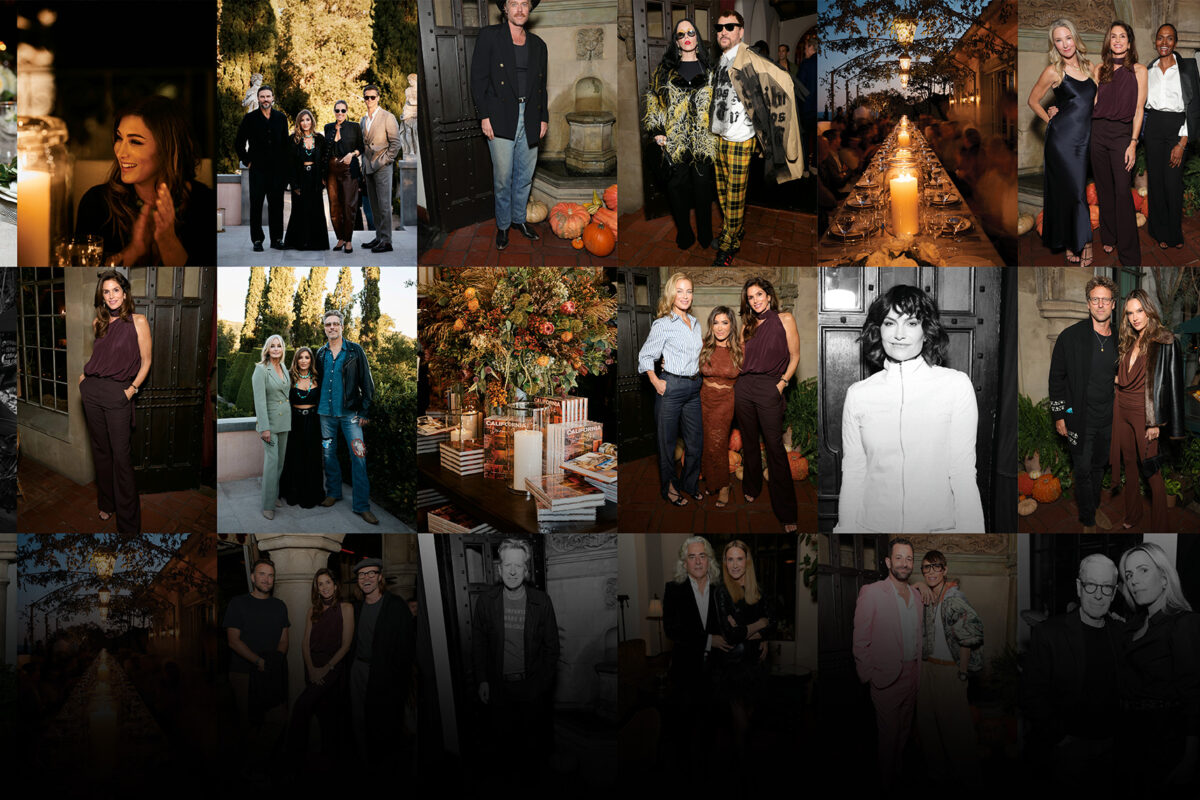With his mighty murals, primal sculptures, and towering totems, the 89-year-old artist helped shape a movement — at last the art world is catching up
Words by HEATHER JOHN FOGARTY
Photography by WE ARE THE RHOADS

Stan Bitters is a man of few words. For more than six decades, the 89-year-old sculptor has been slinging and pounding clay into massive textural murals, fountains, totems, and pots in the relative solitude and anonymity of his Fresno studio. He’s a quiet hulk of a man, his strong hands gripping a two-by-four paddle. He’s using it to beat texture into the surface of a clay mural — destined for an entry to a Beverly Hills home — that is sprawling across his studio floor.
His large-scale work is instantly recognizable: the two-story tile fireplaces at the Ace Hotel in Palm Springs, the 20-foot garden wall at the Shoreham Towers in West Hollywood, the relief of an exterior wall at the United California Bank in Brentwood, a low relief at the Sheraton Suites Chicago O’Hare, and the 31-foot-high sculptures at Westfield Century City. Not to mention his other work for private homes in Malibu, Beverly Hills, Carmel, and beyond. Among fellow artists, he is credited as defining the organic modernist movement of the 1960s, which merged the functionality of modernist architecture with natural elements and materials.
In California, Bitters’ prolific body of work is a familiar and fundamental aesthetic, his large-scale structural forms made from native clay are raw yet in harmony with their environment. But until his Humpies installation in Marinaressa Gardens at the 2024 Venice Biennale — four white freestanding ceramic sculptures (36 to 38 inches tall and two feet wide), primal and echoing the signature protrusions and high relief work seen in his murals — Bitters’ work was largely unrecognized internationally.
“Last year, I got invited to Venice Biennale. René Rietmeijer, the founder of the European Cultural Centre, said I was getting old, and that there wasn’t much more time to be part of this,” Bitters says. “He said, ‘I want you.’” The financial burden of participating, however, was draining, and Bitters has spent the last year trying to catch up, working on commissions, producing smaller-scale items, such as pots, light fixtures, and tiles. “Things are just now working out,” he says.
He sits at a table under the shade of a wisteria vine at his home, where he says 200 butterflies visited last spring. His garden is a living laboratory, where colorful totems, earthy medallions, and fountains from the 1960s keep company with a muted palette of succulents and California native plants. Nearby, his screen of ceramic wind chimes strung together with copper wire cast a bamboo-like pattern on the earth. “I’m not known for sculpture,” he says. “And I always wanted to go big with sculpture, but it was never going to sell. That’s the reality. I needed money. So I’ve been busy all these years with murals.”
“I wanted to go big with sculpture, but it was never going to sell.”
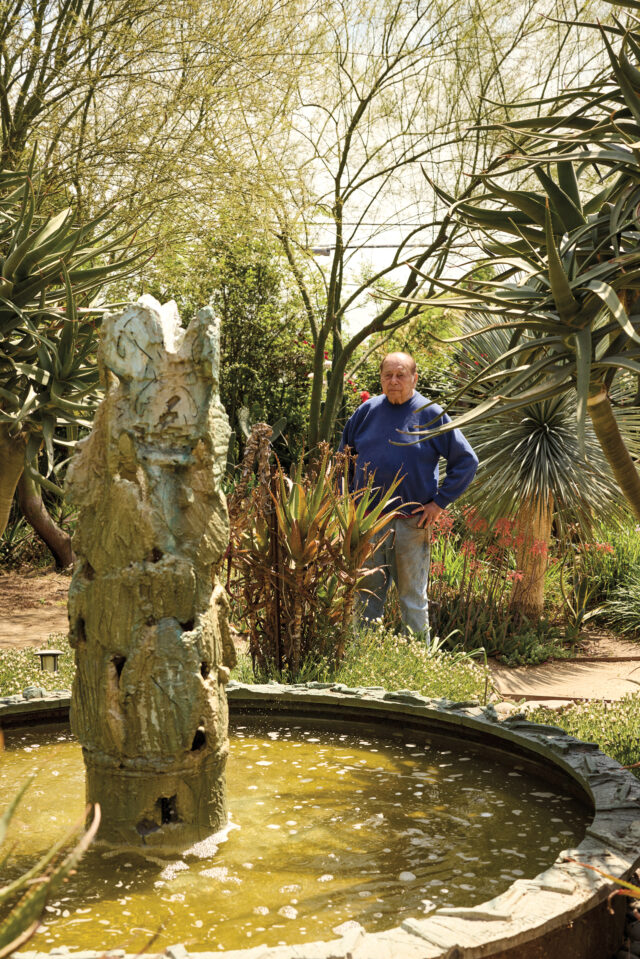
“Considering the installations I’ve seen him working on and how much of his work goes internationally, I think Stan is an American great, and in some capacity underrecognized,” says Laura Young, the managing director of The Future Perfect’s gallery at Goldwyn House in Hollywood Hills, where Bitters’ work from the Biennale is on display through summer.
Young met Bitters when she curated a 2019 group show titled Mess: Expressionism and Experimentation in Contemporary Ceramics. “The show was a presentation of ceramics when ceramics were the hottest thing. Stan made me three of these totemic wrap sculptures, which we put in the show, and then we didn’t hear from him again,” she says, laughing. After last year’s Venice Biennale, Bitters asked Young about bringing those works back to L.A. “I took the pieces before I even knew what they looked like,” she says.
Bitters says going to the Biennale was one of the few times he has left the country, and the experience was draining. (“Too many people.”) In fact, with the exceptions of the odd trip to New York or Dallas for a show, he rarely leaves the state: “I got as far as Arkansas once with a girlfriend driving cross-country,” he admits. He and his two cats shuffle between his unassuming pale yellow ranch house, surrounded by chain-link and bamboo fencing, and a windowless box of a studio a few blocks away. Both are in an industrial park in Fresno where rows of unglazed thumb pots and sculptures sit in a dusty yard, awaiting their turn in an imposing walk-in kiln. “Our kiln is getting old,” Bitters says. Every day, he still mixes 50-pound bags of clay in the same Champion dough mixer he bought secondhand at a bakery-supply store in the 1960s.
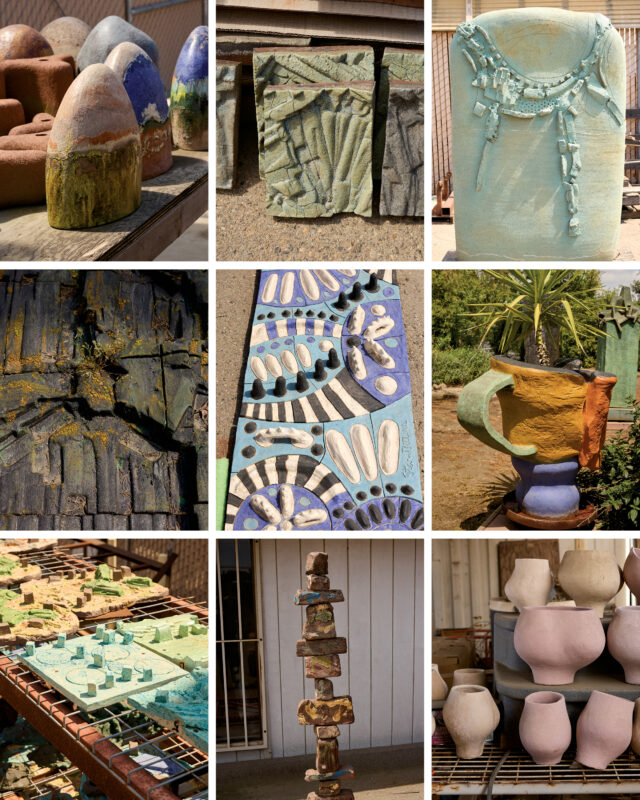
For the past year, his studio floor has resembled a plywood skate park. It has a curved surface, built by a crew of three, that held two enormous concave ceramic mural walls (to be installed on both sides of an entrance to a Trousdale Estates home). “The crew can handle the weight,” Bitters says. “I do the surface stuff, and they lay it out.” He can no longer work on the floor, so he creates atop a makeshift design table. Tom Bryan and Dave Salmu have helped Bitters for more than a decade. They measure the murals and fabricate the steel frames that support the heavier pieces.
Designing large-scale murals with tiles requires some math: Bitters has to account for each tile’s shrinking as it dries outside the kiln, so the mural can be reassembled and aligned. “We used to account for 10 percent an inch of shrinkage,” he says. “The kiln doesn’t get as hot as it used to, so now it’s closer to 9.1 percent.” The calculations and creative design choices required to bring these massive murals to life is staggering.
Bitters experiments with glazes at a table in the corner of the studio, and he says the samples are only an indication of how the final product will emerge from the kiln. Each glaze is unique and, he says, nearly impossible to duplicate. “The finishes have a very earthy feeling that’s inspired by California landscapes,” he says. “It’s open country here, and nature is predominant.”
Commissions such as the Duncan project and the touristy Nut Tree installations use kaleidoscope colors, but Bitters’ original work integrates earthier tones — dusty browns, muted greens, sky blue, rust, and ocher, hues that define the Central Valley landscape.
For the past year, painter Goku McAfee has helped with production full time. Occasionally they pull in a fourth helping hand, but the crew is lean. “We are in survival mode,” Bitters says.
“The finishes have an earthy feeling inspired by California.”
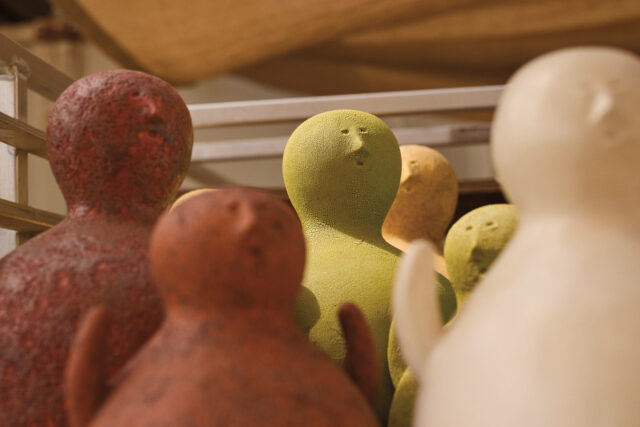
Today, McAfee, whose paintings Bitters discovered in a Fresno gallery several years ago, is on hand to help carry the heavy pieces to the kiln once the design is complete. McAfee says there’s a “tough honesty” that comes from working as an artist in the Central Valley. “It has something to do with the dirt,” McAfee says, as he inspects one of Bitters’ massive fireplace and panel commissions that he’s laid out in an adjacent space. Bitters is a frequent collaborator on commissions from Studio Shamshiri, Jamie Bush, Commune Design, and other notable interior and architectural design firms, and his influence is apparent in ceramists such as Ben Medansky, Peter Lane, Bari Ziperstein, and Sofia Londoño.
“Almost every project I did early on had a piece of Stan’s work in it,” says Pamela Shamshiri, the principal designer for Shamshiri Studios. “We just installed another fireplace two weeks ago.” She met Bitters when she was a partner at Commune Design and commissioned him to create the fireplaces for the Ace Hotel, Palm Springs’s new hot spot. “When you really need a slice of raw nature, Stan’s pieces are so architectural and organic. They change any space they’re in. It’s almost like putting a tree in a room.”
“The architects really embraced his work from early on,” says Scott Nadeau, a cofounder of furniture-design company Ten10 and Bitters’ agent for 23 years. Nadeau and his wife, Joanna, met Bitters when they sold his work at their vintage design store in Silver Lake. Since then they’ve collaborated with him on close to 60 commissions. “I’ve always felt his relevance,” Nadeau says. “Growing up in L.A., the feeling was always there. It’s in your DNA.”
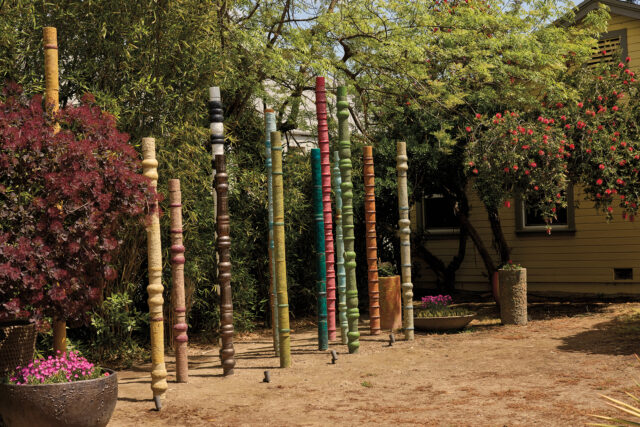
The work is as physical today as it was in 1957, when he discovered the freedom of working with clay as a student at Otis Art Institute. At the time, Bitters was an aspiring painter; as a teen, he had painted signs for businesses. At San Diego State he was inspired by fellow student John Baldessari, whom he followed to study at Otis. It was there that Bitters met legendary abstract expressionist Peter Voulkos, the head of the school’s new ceramics department. “I wasn’t in his class, but I liked to go to the basement during lunch hour when he was there working,” Bitters says. “I was awestruck. He was throwing this shit around like crazy.” Bitters says with his own painting at school, he felt like he was going through the motions. “But when I saw this activity in the basement with clay, I was emotionally involved with the motion. I kept coming back every day.”
Voulkos’s radical methods with clay left their mark on Bitters’ work, but the sheer scale sets the two apart. “Peter Voulkos was a dynamo of energy and a beast of that brutalist approach to ceramics,” Nadeau says. “Stan as a young man channeled this and is still doing it today. But when you look at the scale, his whole thing was pushing it to see how far he could go.”
Bitters completed his undergraduate work at UCLA in 1959 with a degree in painting. He then returned to Fresno, where landed a job in nearby Madera as an artist in residence at Hans Sumpf Company, then the largest producer of adobe brick. He was given 20 pounds of clay “to play around with” and tasked with creating sellable objects. First came the birdhouses. “The birdhouse has nothing to do with birds,” he says. “But I envisioned the shapes hanging from olive trees besides the adobes. It was a functional architectural detail.” Next came Bitters’ hand-coiled pots, earthy and organic in appearance and function. “The thumb pots took off like crazy,” Bitters says. “The pots were inspired by elementary school projects with clay, and kids poking holes in things, but on a larger scale.” Today a 15-inch thumbprint pot starts at $2,200, while vintage pieces can fetch considerably more.
He struck out on his own in 1963, when he began larger-scale sculptures and commissions, such as the towering bronze doors at the Saroyan Theater that feature his signature rondelle details.
“Los Angeles and San Francisco were not ready for this kind of stuff. They were still in the bathroom tile era,” Bitters says. But Fresno was more experimental and open to innovation. Next came 20-by-25-foot exterior and interior murals defined by Bitters’ inimitable textural relief patterns at the Savings and Loan and a cluster of pipe fountains, or what Bitters calls “Dancing Waters,” at the Fulton Mall, which originally spouted water pulsating as high as 14 feet.
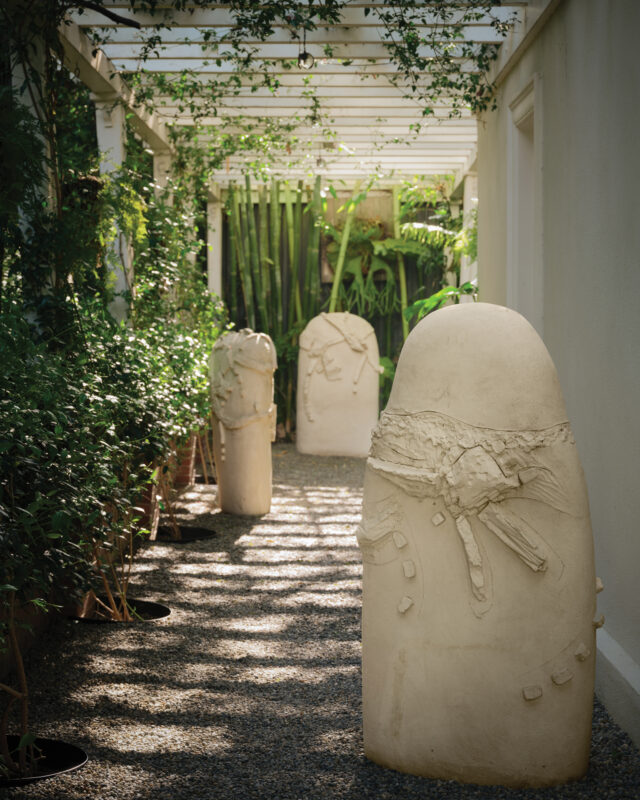
Medallions have become a central motif in Bitters’ work, but initially he envisioned them as oversize lollipops; like the thumb pots, they were inspired by the nature of wonderment experienced in childhood. “Then I imagined the form was a bubble — it was floating,” Bitters says. He chromed the leg of the pole bearing the weight of the medallion. “I wanted to free the visual weight.” He installed several medallions, five to six feet tall, in the front yard of his Fresno farmhouse, which brothers Bob and Dick Duncan passed on their way to golf. “They asked if they could buy the murals for their new building,” Bitters says. “The buildings were completely overwhelming, and the scale of the medallions needed to be much larger.” He was obligated to use Duncan Ceramic Arts’s saturated glazes for the 10-foot medallions adorning a 300-foot relief and given a Herculean deadline of six months to complete the project. “That color zone — the bright, shiny colors — was a challenge,” he adds. A custom-built walk-in kiln was required to complete it. He uses the same one today.
In 2014, Bitters’ work was displayed at the Heath Ceramics Boiler Room. A collaboration with Heath tile followed, drawing national attention. More recently, he has been the subject of the documentary short film Stan Bitters Modern Primitive, which screened at the Palm Springs Modernism Week last year to a sold-out crowd. Francesca Di Amico, one of the film’s producers, says she and Claudia Unger of Minx Films are expanding the film to feature length. “A deep bond grew between us when we were filming, and we’ve kept up our relationship,” she says. The duo filmed Bitters at the Venice Biennale, and Di Amico says she appreciates his impact even more. “As we expand our piece, we continue to understand how to articulate the California-ness of his work and how it echoes,” she says. “It’s in Malibu. It’s in Fresno. It’s a way of breathing in California.”
Bitters says he’s still a work in progress. After he finishes the fireplace commission, he wants to return to painting. “When I’ve finished and I have the freedom to experiment,” he says, “why not take these murals in a more painterly direction, instead of on a canvas on a hard surface?”
Bitters turns, passing yellow Cotula blooms around a stacked slab fountain and a five-foot medallion (signed by Bitters in 1965). He walks back into the house. A fireplace is unfinished, which Bitters says he will complete “someday,” and the only furniture in the room is a tableful of acrylic paints and rags and a director’s chair sitting in front of Bitters’s latest work. A painting on canvas.
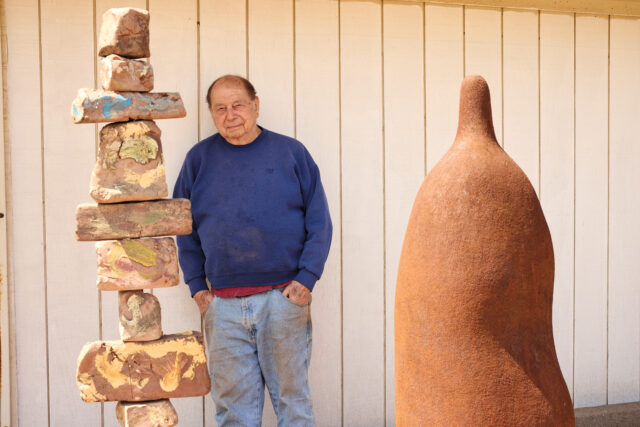

Feature image: Stan Bitters.
This story originally appeared in the Summer 2025 issue of C Magazine.
Discover more DESIGN news.
See the story in our digital edition




